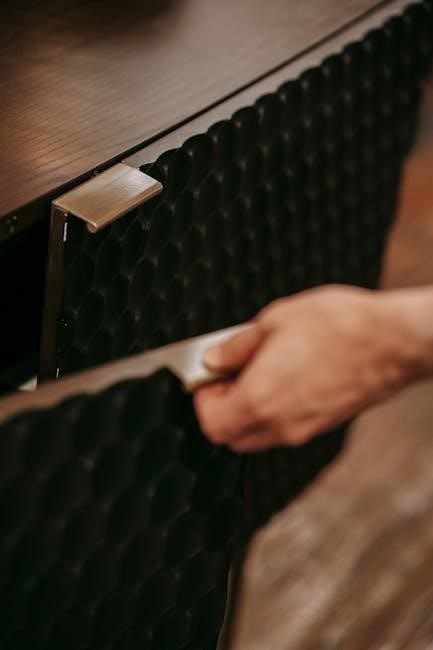The Lexus manual key failing to open the door is a common issue, often due to dead batteries, faulty mechanisms, or damaged keys, requiring immediate attention.

1.1 Understanding the Problem
The issue of a Lexus manual key failing to open the door can stem from various factors, including a dead key fob battery, a faulty door lock mechanism, or physical damage to the key itself. In some cases, the key may turn but fail to engage the lock properly, while in others, it may not turn at all. This problem often arises unexpectedly, leaving owners stranded. Understanding the root cause is crucial for resolving the issue effectively, whether through simple troubleshooting or requiring professional assistance. Identifying the specific fault helps in applying the correct solution to regain access to the vehicle.
1.2 Common Scenarios When the Manual Key Fails to Open the Door
Drivers often encounter the issue of a Lexus manual key failing to open the door in several common scenarios. One prevalent situation is after an extended period of vehicle inactivity, such as during vacations, where the key fob battery may drain completely, rendering both the remote and manual key ineffective. Another scenario involves physical damage to the key, such as bending or warping, which prevents it from fitting or turning in the lock. Additionally, owners may experience this problem if the door lock mechanism becomes jammed or corroded due to environmental factors, such as rain or humidity, further complicating the issue.
Why the Manual Key Might Not Work
The manual key may fail due to a dead key fob battery, a faulty door lock mechanism, or a bent/damaged key, preventing proper door operation.
2.1 Dead Battery in the Key Fob
A dead battery in the key fob is a common cause for the manual key failing to open the door. The key fob relies on a small battery to transmit signals to the car’s electronic system. If the battery is dead, the fob cannot communicate with the vehicle, preventing the door from unlocking even with the manual key. Symptoms include unresponsive buttons on the fob and the car not recognizing the key. To verify, press any button on the fob; if there’s no response, the battery is likely dead. Replacing the battery usually resolves the issue, restoring proper functionality to both the fob and the manual key.
2.2 Faulty Door Lock Mechanism

A faulty door lock mechanism can prevent the manual key from opening the door. Over time, the lock may become worn or jammed due to dirt, debris, or mechanical failure. If the lock is malfunctioning, the key may not engage properly, even if it’s in good condition. Symptoms include difficulty turning the key or the key getting stuck in the lock. To diagnose this, try using the key on another door; if it works elsewhere, the issue is likely with the specific door’s lock mechanism. Cleaning the lock with lubricant or consulting a locksmith may resolve the problem. Regular maintenance can help prevent such issues.
2.3 Bent or Damaged Key
A bent or damaged manual key can fail to open the door due to improper alignment with the lock mechanism. If the key is warped or has broken teeth, it may not engage the lock properly. Rough handling or accidental bending can cause this issue. Users have reported that a damaged key may turn in the lock but fail to activate the unlocking mechanism. In such cases, using a spare key is recommended. If no spare is available, a locksmith can repair or replace the key. Regular inspection of the key for wear and tear can prevent such problems from arising. Proper storage and handling are essential to maintain the key’s functionality.

Troubleshooting Steps
Begin by checking the key fob battery, inspecting the door lock for damage, and testing the key on other doors to identify the issue quickly.
3.1 Checking the Key Fob Battery
A dead battery in the key fob is a common cause of the manual key failing to open the door. To check, press any button on the fob. If it doesn’t respond, the battery may be dead. Replace it with a new CR2032 or equivalent battery. Ensure proper installation and test the fob again. If it works, the door should unlock. This simple step can resolve the issue quickly without further complications.
3.2 Inspecting the Door Lock for Damage

Inspecting the door lock is crucial when the manual key fails to open the door. Look for visible damage, wear, or corrosion on the lock mechanism. Clean the lock with a lubricant like WD40 to remove grime. If the lock is bent or broken, it may need professional repair or replacement. Ensure the key aligns properly when inserted, as misalignment can prevent unlocking. If the issue persists, consider consulting a locksmith or dealership for specialized assistance. Regular maintenance, such as lubricating locks, can help prevent future problems and ensure smooth operation.

3.3 Testing the Key in Different Doors
Testing the manual key in other doors can help identify if the issue is specific to one door or the key itself. Try inserting the key into the passenger or rear doors to see if it unlocks them. If the key works on other doors, the problem may lie with the driver’s door lock mechanism. If the key fails on all doors, it could indicate a worn or damaged key. Inspect the key for visible wear or bends and consider using a spare key if available. This step helps narrow down the root cause of the unlocking problem efficiently.

Emergency Procedures to Open the Door
In emergencies, use the emergency key hidden in the fob or check the door lock for mechanical issues. Consider professional assistance if problems persist.
4.1 Using the Emergency Key
If the manual key fails, the emergency key hidden within the fob can be used. Ensure the key is fully extended and aligned with the lock. Turn it gently but firmly. If it doesn’t budge, check for damage or debris in the lock. Lubricating the lock may help. If the key still doesn’t work, the issue may be with the lock mechanism itself. In such cases, seek professional assistance to avoid further damage. Always handle the emergency key with care to prevent breakage.

4.2 Alternative Methods to Gain Access
If the emergency key fails, consider using a thin wire or tool to manipulate the door lock mechanism manually. Spray lubricant like WD40 into the keyhole to loosen any internal parts. Gently prying the door open may work but risks damage. Another option is to unlock another door and access the stuck door from inside. If all else fails, contact a professional locksmith or Lexus specialist. They can repair or replace the lock without damaging the vehicle. Always prioritize careful methods to avoid further complications and ensure the issue is resolved effectively. Professional assistance is recommended for complex cases to maintain your car’s integrity;
Repair and Maintenance Tips
Regularly lubricate door locks to prevent jamming and ensure smooth operation. Replace worn-out keys and maintain the key fob battery to avoid lock-related issues. Schedule periodic inspections to identify and fix potential problems early, ensuring reliable access to your Lexus.
5.1 Replacing the Key Fob Battery
To replace the key fob battery, start by checking if the battery is dead by pressing any button on the fob. If it doesn’t respond, the battery likely needs replacement. Open the fob by locating the small screw or clip on the back and carefully removing it with a screwdriver. Gently pry the fob open to access the battery compartment. Replace the old battery with a new one, ensuring the correct polarity. Reassemble the fob and test it by unlocking your Lexus door. If the issue persists, consider consulting a professional or checking for proper battery alignment, as misalignment can prevent functionality and lead to further issues. Always test the fob on multiple doors to ensure full system restoration and reliable access to your vehicle.
5.2 Lubricating the Door Lock
Lubricating the door lock is a simple yet effective solution to address issues with the manual key not opening the door. Over time, dirt and grime can accumulate inside the lock, causing it to stiffen or stick. To resolve this, use a penetrating oil like WD-40 or a silicone-based lubricant. Insert the straw from the spray can into the keyhole and apply a small amount of lubricant. Gently move the key in and out several times to ensure the lubricant spreads evenly. Avoid over-saturating, as excess lubricant can attract more dirt. This maintenance step helps restore smooth operation to the lock mechanism, ensuring the key functions properly and prevents future issues. Regular lubrication is a proactive way to maintain your Lexus’s door locks and avoid potential problems.
5.3 Professional Assistance When Needed
If troubleshooting steps fail to resolve the issue, seeking professional assistance is essential. A qualified Lexus specialist or locksmith can diagnose complex problems, such as internal lock damage or electrical malfunctions. They possess the tools and expertise to repair or replace faulty components, ensuring proper functionality. Additionally, professionals can address issues like bent or damaged keys and reprogram key fobs if necessary. Don’t hesitate to consult an expert to avoid further complications and ensure your vehicle’s security and convenience are restored. Regular professional maintenance can also help prevent future issues with your Lexus’s locking system.
